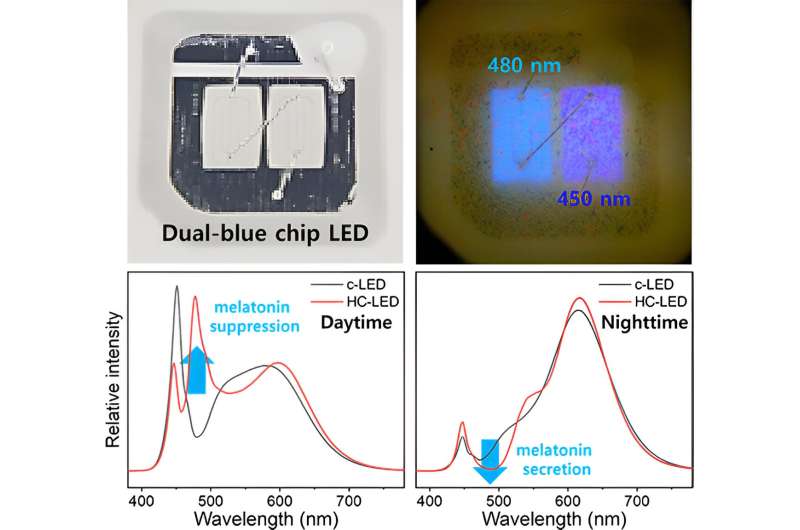This article has been reviewed according to Science X's editorial process and policies. Editors have highlighted the following attributes while ensuring the content's credibility:
fact-checked
peer-reviewed publication
trusted source
proofread
This next generation blue light could potentially promote or hinder sleep on command

Blue light from LED lamps and consumer electronics can mess with your sleep because it disrupts production of the natural sleep hormone melatonin. Tinted glasses or displays in night mode can mask, but don't remove, a portion of the disruptive wavelengths. But now, researchers report in ACS Omega that they have designed more "human-centric" LEDs that could potentially enhance drowsiness or alertness on command.
Humans have evolved over millennia to be active during the day and to rest at night; we've depended on the sun to regulate our sleep/wake cycle. But many people today spend the majority of their time indoors, shielded from the sun, so it's harder for them to maintain that optimal 24-hour circadian rhythm. Exposure to artificial light can worsen this problem because it can decrease the secretion of melatonin.
Nighttime exposure to blue light, specifically, is notorious for interfering with melatonin production and, therefore, sleep. However, blue light is emitted by LEDs in lamps, computers, TVs, phones, and other handheld electronics that people often use at night. So, Changwook Kim, Young Rag Do, and colleagues set out to make a light source that could support natural circadian rhythms, no matter what time of day it is used.
Blue light ranges in wavelength from 380 to 500 nanometers (nm), but not all blue light is created equal. The wavelengths that suppress melatonin production—and cause wakefulness—are in the range of 460 to 500 nm.
So, the researchers designed two LEDs that emitted different wavelengths of blue light. One LED, intended for daytime use, restricted its blue emissions to wavelengths close to 475 nm. The other LED, for evening use, emitted blue wavelengths near 450 nm, outside the range that disturbs sleep.
Then, the researchers built these two new LEDs into bulbs. Like conventional bulbs, they produced white light by converting some of the blue light into red and green with the help of phosphors encased in the bulbs. The new LED bulbs were placed along with conventional LED bulbs in fixtures installed in the ceiling of a windowless room furnished with a desk, treadmill, and bed.
Individual male volunteers stayed in the room for a stretch of three days. A computer controlled which type of LED was turned on or off during their stay; that way, the researchers could compare the impact on melatonin levels of conventional bulbs versus the new daytime and evening bulbs.
Saliva samples from 22 volunteers showed that using the new LEDs increased the participants' nighttime melatonin levels by 12.2% and reduced daytime melatonin by 21.9% compared to consistent conventional LED exposure. The researchers hope manufacturers of LED lamps and electronic displays can apply these findings to help people increase daytime vitality and work efficiency while also improving nighttime relaxation and sleep quality.
More information: Yun Jae Eo et al, Development and Verification of a 480 nm Blue Light Enhanced/Reduced Human-Centric LED for Light-Induced Melatonin Concentration Control, ACS Omega (2023). DOI: 10.1021/acsomega.3c05620




















